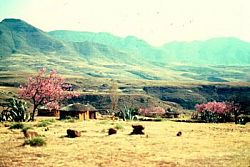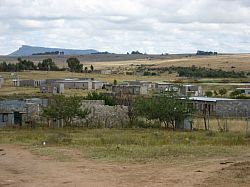 Besotho trees and rural houses 1970s
Besotho trees and rural houses 1970s
 Besotho trees and urban houses 2007
Besotho trees and urban houses 2007
The largely treeless savanna and alpine vegetation of the mountainous Kingdom of Lesotho, in southern Africa, has inspired tree planting activities since the first arrival of Europeans in 1833. Missionaries from the Paris Evangelical Society brought in their wagons planting materials for both fruit and fuel wood trees, as well as wheat, a range of vegetables, cats and pigs. By the time Chief Mosheoshoe asked the British for a protective alliance in 1868, the Basotho (residents of Lesotho) had begun to plant peach trees in their gardens, buy ploughs to cultivate land for wheat, keep cats around their granaries, and raise pigs. The fourth British government representative, Col. Charles Duncan Griffith (1871-1881), advocated afforestation and offered a prize in 1876 to the person who planted and took care of the largest number of trees. Government programmes in the 20th century led to the creation of tree nurseries - and the planting of an estimated 50 million trees. Both the fate of these trees and the consequences of their introduction for the landscape have not been studied.
The largest mass tree planting in existence are those of the former woodlot project (1973-1987). This project supported not only tree planting, but also training Basotho as foresters and the creation of a forestry presence within government. The Forestry Act of 1978 was enacted to support the development of woodlots. These woodlots were then proclaimed 'Forest Reserves'. Bureaucratically, first a Unit, and then a Division, within the Ministry of Agriculture was created. Basotho returning from overseas training in forestry were hired as staff. The
Forestry Division became the Forestry Department within the new Ministry of Forestry and Land Reclamation , and, in conjunction with the Food and Agriculture Organization of the United Nations (FAO), set a national target of achieving 5% tree cover by 2020 by planting 1,500,000 trees a year.


